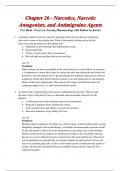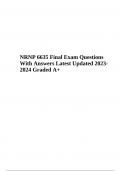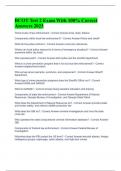Exam (elaborations)
Chapter 26 - Narcotics, Narcotic Antagonists, and Antimigraine Agents |Test Bank - Focus on Nursing Pharmacology (8th Edition by Karch)
- Course
- Institution
1. A geriatric patient received a narcotic analgesic before leaving the post-anesthesia care unit to return to the regular unit. What is the priority nursing action for the nurse receiving the patient on the regular unit? a. Administer a non-steroidal anti-inflammatory drug. b. Encourage fluids. ...
[Show more]





